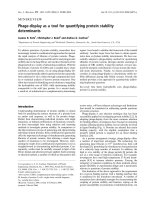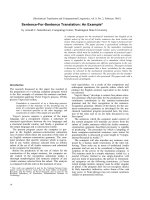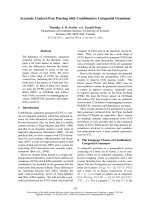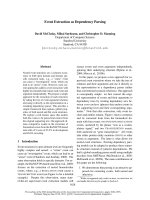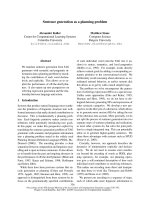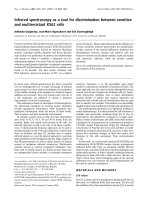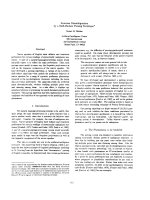Báo cáo khoa học: "Sentence Planning as Description Using Tree Adjoining Grammar " pptx
Bạn đang xem bản rút gọn của tài liệu. Xem và tải ngay bản đầy đủ của tài liệu tại đây (699.67 KB, 8 trang )
Sentence Planning as Description Using Tree Adjoining Grammar *
Matthew Stone Christine Doran
Department of Computer and Information Science Department of Linguistics
University of Pennsylvania University of Pennsylvania
Philadelphia, PA 19014 Philadelphia, PA 19014
matthew@linc, cis. upenn, edu cdoran@linc, cis. upenn, edu
Abstract
We present an algorithm for simultaneously
constructing both the syntax and semantics of
a sentence using a Lexicalized Tree Adjoin-
ing Grammar (LTAG). This approach captures
naturally and elegantly the interaction between
pragmatic and syntactic constraints on descrip-
tions in a sentence, and the inferential interac-
tions between multiple descriptions in a sen-
tence. At the same time, it exploits linguis-
tically motivated, declarative specifications of
the discourse functions of syntactic construc-
tions to make contextually appropriate syntac-
tic choices.
1 Introduction
Since (Meteer, 1991), researchers in natural language
generation have recognized the need to refine and re-
organize content after the rhetorical organization of ar-
guments and before the syntactic realization of phrases.
This process has been named
sentence planning
(Ram-
bow and Korelsky, 1992). Broadly speaking, it involves
aggregating content into sentence-sized units, and then
selecting the lexical and syntactic elements that are used
in realizing each sentence. Here, we consider this second
process.
The challenge lies in integrating constraints from syn-
tax, semantics and pragmatics. Although most generation
systems pipeline decisions (Reiter, 1994), we believe the
most efficient and flexible way to integrate constraints
in sentence planning is to synchronize the decisions. In
this paper, we provide a natural framework for dealing
with interactions and ensuring contextually appropriate
output in a single pass. As in (Yang et al., 1991), Lex-
icalized Tree Adjoining Grammar (LTAG) provides an
*The authors thank Aravind Joshi, Mark Steedman, Martha
Palmer, Ellen Prince, Owen Rambow, Mike White, Betty
Birner, and the participants of INLG96 for their helpful com-
ments on various incarnations of this work. This work has been
supported by NSF and IRCS graduate fellowships, NSF grant
NSF-STC SBR 8920230, ARPA grant N00014-94 and ARt
grant DAAH04-94-G0426.
abstraction of the combinatorial properties of words. We
combine LTAG syntax with declarative specifications of
semantics and pragmatics of words and constructions, so
that we can build the syntax and semantics of sentences
simultaneously. To drive this process, we take
descrip-
tion
as the paradigm for sentence planning. Our planner,
SPUD (Sentence Planner Using Descriptions), takes in a
collection of goals to achieve in describing an event or
state in the world; SPUD incrementally and recursively
applies lexical specifications to determine which entities
to describe and what information to include about them.
Our system is unique in the streamlined organization of
the grammar, and in its evaluation both of contextual ap-
propriateness of pragmatics and of descriptive adequacy
of semantics.
The organization of the paper is as follows. In sec-
tion 2, we review research on generating referring ex-
pressions and motivate our treatment of sentences as re-
ferring expressions. Then, in section 3, we present the
linguistic underpinnings of our work. In section 4, we
describe our algorithm and its operation on an example.
Finally, in section 5 we compare our system with related
approaches.
2 Sentences as referring expressions
Our proposal is to treat the realization of sentences as
parallel to the construction of referring expressions, and
thereby bring to bear modern discourse-oriented theories
of semantics and the idea that language use is INTEN-
TIONAL ACTION.
Semantically, a DESCRIPTION D is just an open formula.
D applies
to a sequence of entities when substituting them
for the variables in D yields a true formula. D REFERS to
C jUSt in case it
distinguishes
c from its DISTRACTORS
that is D applies to c but to no other salient alternatives.
Given a sufficiently rich logical language, the meaning
of a natural language sentence can be represented as a
description in this sense, by assuming sentences refer to
entities in a DISCOURSE MODEL, cf. alternative semantics
(Karttunen and Peters, 1979; Rooth, 1985).
Pragmatic analyses of referring expressions model
speakers as PLANNING those expressions to achieve sev-
eral different kinds of intentions (Donellan, 1966; Appelt,
198
1985; Kronfeld, 1986). Given a set of entities to describe
and a set of intentions to achieve in describing them, a
plan is constructed by applying operators that enrich the
content of the description until all intentions are satisfied.
Recent work on generating definite referring NPs (Reiter,
1991 ; Dale and Haddock, 1991; Reiter and Dale, 1992;
Horacek, 1995) has emphasized how circumscribed in-
stantiations of this procedure can exploit linguistic con-
text and convention to arrive quickly at short, unambigu-
ous descriptions. For example, (Reiter and Dale, 1992)
apply generalizations about the salience of properties of
objects and conventions about what words make base-
level attributions to incrementally select words for inclu-
sion in a description. (Dale and Haddock, 1991) use a
constraint network to represent the distractors described
by a complex referring NP, and incrementally select a
property or relation that rules out as many alternatives as
possible. Our approach is to extend such NP planning
procedures to apply to sentences, using TAG syntax and
a rich semantics.
Treating sentences as referring expressions allows us
to encompass the strengths of many disparate proposals.
Incorporating material into descriptions of a variety of
entities until the addressee can infer desired conclusions
allows the sentence planner to
enrich
input content, so
that descriptions refer successfully (Dale and Haddock,
1991) or
reduce
it, to eliminate redundancy (McDonald,
1992). Moreover, selecting alternatives on the basis of
their syntactic, semantic, and pragmatic contributions to
the sentence using TAG allows the sentence planner to
choose words in tandem with appropriate syntax (Yang et
al., 1991), in a flexible order (Elhadad and Robin, 1992),
and, if necessary, in conventional combinations (Smadja
and McKeown, 1991; Wanner, 1994).
3 Linguistic Specifications
Realizing this procedure requires a declarative specifica-
tion of three kinds of information: first, what operators
are available and how they may combine; second, how
operators specify the content of a description; and third,
how operators achieve pragmatic effects. We represent
operators as elementary trees in LTAG, and use TAG op-
erations to combine them; we give the meaning of each
tree as a formula in an ontologically promiscuous rep-
resentation language; and, we model the pragmatics of
operators by associating with each tree a set of discourse
constraints describing when that operator can and should
be used.
Other frameworks have the capability to make com-
parable specifications; for example, HPSG (Pollard and
Sag, 1994) feature structures describe syntax
(SUBCAT),
semantics (CONTI3NT)
and pragmatics
(CONTEXT).
We
choose TAG because it enables local specification of syn-
tactic dependencies in explicit constructions and flexibil-
ity in incorporating modifiers; further, it is a constrained
grammar formalism with tractable computational proper-
ties.
3.1 Syntactic specification
TAG (Joshi et al., 1975) is a grammar formalism built
around two operations that combine pairs of trees, SUB-
STITUTION and ADJOINING. A TAG grammar consists of
a finite set
of ELEMENTARY
trees, which can be combined
by these substitution and adjoining operations to produce
derived trees recognized by the grammar. In substitu-
tion, the root of the first tree is identified with a leaf of the
second tree, called the substitution site. Adjoining is a
more complicated splicing operation, where the first tree
replaces the subtree of the second tree rooted at a node
called the adjunction site; that subtree is then substituted
back into the first tree at a distinguished leaf called the
FOOT node. Elementary trees without foot nodes are
called INITIAL trees and can only substitute; trees with
foot nodes are called AUXILIARY trees, and must adjoin.
(The symbol $ marks substitution sites, and the symbol
* marks the foot node.) Figure l(a) shows an initial tree
representing
the book.
Figure l(b) shows an auxiliary
tree representing the modifier
syntax,
which could adjoin
into the tree for
the book
to give
the syntax book.
Our grammar incorporates two additional principles.
First, the grammar is LEXICALIZED (Schabes, 1990): each
elementary structure in the grammar contains at least
one lexical item. Second, our trees include FEATURES,
following (Vijay-Shanker, 1987).
LTAG elementary trees abstract the combinatorial
properties of words in a linguistically appealing way. All
predicate-argument structures are localized within a sin-
gle elementary tree, even in long-distance relationships,
so elementary trees give a natural domain of locality
over which to state semantic and pragmatic constraints.
The LTAG formalism does not dictate particular syntactic
analyses; ours follow basic GB conventions.
3.2
Semantics
We specify the semantics of trees by applying two prin-
ciples to the LTAG formalism. First, we adopt an ONTO-
LOGICALLY PROMISCUOUS representation (Hobbs, 1985)
that includes a wide variety of types of entities. On-
tological promiscuity offers a simple syntax-semantics
interface. The meaning of a tree is just the CONJUNCTION
of the meanings of the elementary trees used to derive it,
once appropriate parameters are recovered. Such fiat se-
mantics is enjoying a resurgence in NLP; see (Copestake
et al., 1997) for an overview and formalism. Second,
we constrain these parameters syntactically, by labeling
each syntactic node as supplying information about a par-
ticular entity or collection of entities, as in Jackendoff's
X-bar semantics (Jackendoff, 1990). A node X:X (about
×) can only substitute or adjoin into another node with the
same label. These semantic parameters are instantiated
using a knowledge base (cf. figure 7).
For Jackendoff, noun phrases describe ordinary indi-
viduals, while PPs describe PLACES or PATHS and VPs
describe ACTIONS and EVENTUALITIES (in terms of a Re-
ichenbachian reference point). Under these assumptions,
the trees of figure 1, are elaborated for semantics as in
199
S
N
NP, s
DetP N /~
[ I N N* NPJ, VP
D book /~
V NP
I I
the
(h)
(a)
have ¢
(c)
Figure 1: Sample LTAG trees: (a) NP, (b) Noun-Noun Compound, (c) Topicalized Transitive
NP :
<l>x
DetP
N
:
<1>
[ ,
Det book
I
the
book(x)
(a)
N : <l>x
N : syntax N* : <1>
t
syntax
concerns(x, syntax)
(b)
S : <l><r,havlng>
NPJ. : <2>havee S : <1>
NP;. :
hayer VP:
<1>
V NP : <2>
I I
/have/ t
during(r, having) ^ have(having, hayer, havee)
(c)
Figure 2: LTAG trees with semantic specifications
figure 2. Ontological promiscuity makes it possible to
explore more complicated analyses in this general frame-
work. For example, in (Stone and Doran, 1996), we use
reference to properties, actions and belief contexts (Bal-
lim et al., 1991) to describe semantic collocations (Puste-
jovsky, 1991) and idiomatic composition (Nunberg et al.,
1994).
3.3 Pragmatics
Different constructions make different assumptions about
the status of entities and propositions in the discourse,
which we model by including in each tree a specification
of the contextual conditions under which use of the tree
is pragmatically licensed. We have selected four repre-
sentative pragmatic distinctions for our implementation;
however, the framework does not commit one to the use
of particular theories.
We use the following distinctions. First, entities differ
in NEWNESS (Prince, 1981). At any point, an entity is ei-
ther new or old to the HEARER and either new or old to the
DISCOURSE. Second, entities differ in SALIENCE (Grosz
and Sidner, 1986; Grosz et al., 1995). Salience assigns
each entity a position in a partial order that indicates
how accessible it is for reference in the current con-
text. Third, entities are related by salient PARTIALLY-
ORDERED SET (POSET) RELATIONS to
other entities in the
context (Hirschberg, 1985). These relations include part
and whole, subset and superset, and membership in a
common class. Finally, the discourse may distinguish
some OPEN PROPOSITIONS (propositions containing free
variables) as being under discussion (Prince, 1986). We
assume that information of these four kinds is available
in a model of the current discourse state.
The applicability conditions of constructions can freely
make reference to this information. In particular, NP trees
include the determiner (the determiner does not have a
separate tree), the head noun, and pragmatic conditions
that match the determiner with the status of the entity
in context, as in 3(a). Following (Gundel et al., 1993),
the definite article
the
may be used when the entity is
UNIQUELY
IDENTIFIABLE in the discourse model, i.e. the
hearer knows or can infer the existence of this entity and
can distinguish it from any other hearer-old entity of equal
or greater salience. (Note that this test only determines
the status of the entity in context; we ensure separately
that the sentence includes enough content to distinguish
200
NP : <l>x
N : <I>x
DetP N : ,:1> / ~
- \
N : syntax N*
I
Det book
I syntax
the
concerns(x, syntax)
[always applicable]
book(x) (b)
(unique-id(x))
(a)
: <1>
S : <l><r, having>
NP~ :<2>havee S : <1>
NP,L :
hayer VP:
<1>
V NP : <2>
/have/ E
during(r, having)
^
have(having, hayer, havee)
(in-poset(havee), in-op(have(having, haver, havee)))
(c)
Figure 3: LTAG trees with semantic and pragmatic specifications
the entity from all its alternatives.) In contrast, the indef-
inite articles,
a, an,
and 0, are used for entities that are
NOT uniquely identifiable.
S trees specify the main verb and the number and po-
sition of its arguments. Our S trees specify the unmarked
SVO order or one of a number of fancy variants: topical-
ization (TOP),
left-dislocation
(LD),
and locative inversion
(INV). We follow the analysis of TOP in (Ward, 1985).
For Ward, TOP is not a topic-marking construction at all.
Rather, TOP is felicitous as long as (1) the fronted NP is in
a salient poset relation to the previous discourse and (2)
the utterance conveys a salient open proposition which
is formed by replacing the tonically stressed constituent
with a variable (3(c)). Likewise, we follow (Prince, 1993)
and (Birner, 1992) for LD and INV respectively.
4 SPUD
4.1 The algorithm
Our system takes two types of goals. First, goals of
the form
distinguish x as cat
instruct the algorithm to
construct a description of entity x using the syntactic
category
cat.
Ifx is uniquely identifiable in the discourse
model, then this goal is only satisfied when the meaning
planned so far distinguishes x for the hearer. Ifx is hearer
new, this goal is satisfied by including any constituent
of type
cat.
Second, goals of the form
communicate p
instruct the algorithm to include the proposition p. This
goal is satisfied as long as the sentence IMPLIES p given
shared common-sense knowledge.
In each iteration, our algorithm must determine the ap-
propriate elementary tree to incorporate into the current
description. It performs this task in two steps to take
advantage of the regular associations between words and
trees in the lexicon. Sample lexical entries are shown
in figure 4. They associate a word with the semantics
of the word, special pragmatic restrictions on the use of
the word, and a set of trees that describe the combina-
tory possibilities for realizing the word and may impose
additional pragmatic restrictions. Tree types are shared
between lexical items (figure 5). This allows us to spec-
ify the pragmatic constraints associated with the tree type
once, regardless of which verb selects it. Moreover, we
can determine which tree to use by looking at each tree
ONCE per instantiation of its arguments, even when the
same tree is associated with multiple lexical items.
Hence, the first step is to identify applicable lexical
entries by meaning: these items must truly and appropri-
ately describe some entity; they must anchor trees that can
substitute or adjoin into a node that describes the entity;
and they must distinguish entities from their distractors
or entail required information. Then, the second step
identifies which of the associated trees are applicable,
by testing their pragmatic conditions against the current
representation of discourse. The algorithm identifies the
combinations of words and trees that satisfy the most
communicate
goals and eliminate the most distractors.
From these, it selects the entry with the most specific se-
mantic and pragmatic licensing conditions. This means
that the algorithm generates the most marked licensed
form. In (Stone and Doran, 1996) we explore the use
of additional factors, such as attentional state and lexical
preferences, in this step.
The new tree is then substituted or adjoined into the
existing tree at the appropriate node. The entry may
specify additional goals, because it describes one entity
in terms of a new one. These new goals are added to the
current goals, and then the algorithm repeats.
Note that this algorithm performs greedy search. To
avoid backtracking, we choose uninflected forms. Mor-
phological features are set wherever possible as a result
of the general unification processes in the grammar; the
inflected form is determined from the lemma and its as-
sociated features in a post-processing step.
The specification of this algorithm is summarized in
the following pseudocode:
201
STEM
/buy/
/sell/
/purchase/
/book/
SEMANTICS S YNTAX PRAGMATICS
S buyer/buy/bought/from/seller, etc. register(informal)
S seller~sell~bought~to~buyer,
etc. register(informal)
S buyer/purchase/bought/from/seller, etc. register(formal)
book(x) /a//book/, etc. [always possible]
S = buy(buying,buyer, seller, bought)
Figure 4: Sample entries from the lexicon
SUBCAT FRAME TREES PRAGMATICS
Intransitive Active [always possible]
Transitive Active [always possible]
Topicalized Object in-poset(obj), in-op(event)
Left-Dislocated Object
in-poset(obj)
Ditransitive Active [always possible]
Topicalized Dir Object in-poset(dir obj), in-op(event)
Left-Dislocated Dir Object in-poset(dir obj)
PP Predicative Active [always possible]
Locative Inversion newer-than(subj,loc)
etc.
Figure 5: Sample entries from the tree database
until goals are satisfied:
determine which uninflected forms apply;
determine which associated trees apply;
evaluate progress towards goals;
incorporate most specific, best ( form, tree ):
perform adjunction or substitution;
conjoin new semantics;
add any additional goals;
4.2 The system
SPUD's
grammar currently includes a range of syntactic
constructions, including adjective and PP modification,
relative clauses, idioms and various verbal alternations.
Each is associated with a semantic and pragmatic specifi-
cation as discussed above and illustrated in figures 4 and
5. These linguistic specifications can apply across many
domains.
In each domain, an extensive set of inferences, pre-
sumed known in common with the user, are required to
ensure appropriate behavior. We use logic programming
to capture these inferences. In our domain, the system
has the role of a librarian answering patrons' queries.
Our specifications define: the properties and identities of
objects (e.g., attributes of books, parts of the library); the
taxonomic relationships among terms (e.g., that a service
desk is an area but not a room); and the typical span and
course of events in the domain (e.g., rules about how
to check out books). This information is complete and
available for each lexical entry. Of course, SPUD also
represents its private knowledge about the domain. This
includes facts like the status of books in the library.
4.3 An example
Suppose our system is given the task of answering the
following question:
(1) Do you have the books for Syntax 551 and
Pragmatics 590?
Figure 6 shows part of the discourse model after process-
ing the question. The two books, the set they comprise
(introducing a poset relation), and the library are men-
tioned in (1). Hence, these entities must be both hearer-
old and discourse-old. As in centering (Grosz et al.,
1995), the subject is taken to be the most salient entity.
Finally, the meaning of the question becomes a salient
open proposition.
On the basis of the knowledge in figure 7, a rhetor-
ical planner might decide to answer by describing state
have27 as an S and lose5 likewise. To construct its refer-
ence to have27, SPUD first determines which lexical and
syntactic options are available. Using the lexicon and in-
formation about have27 available from figure 7(b), SPUD
determines that, of lemmas that truthfully and appropri-
ately describe have27 as an S,/have/has the most spe-
cific licensing conditions. The tree set for/have/includes
unmarked, LD and TOP trees. All are licensed, because
of the poset relation R between book19 and books and
the salient open proposition O. We choose TOP, the tree
with the most specific condition TOP requires R and O,
while
LD
requires only R and the unmarked form has no
requirements.
Thus, a topicalized /have/ tree, appropriately instan-
tiated as shown in figure 8, is added to the description.
The tree refers to three new entities, the object book19,
the subject library and the reference point r of the tense.
202
STATUS
DISCOURSE OLD:
HEARER OLD:
SALIENCE:
POSET RELATIONS:
" OPEN PROPOSITION:
ENTITIES
book19, book2, books, library, patron
bookl 9, book2, books, library, patron
{library, patron} > { bookl 9, book2, books}
book19
MEMBER-OF
books; book2
MEMBER-OF
books
library X have Y:
X={does/doesn't};
Y E books.
Figure 6: Discourse model for the example
book(book19)
book(book2)
concerns(book19, syntax)
concerns(book2, pragrnatics)
(a) Common Knowledge
have(have27, library, book19)
lost(lose5, book2)
during (have27, now)
during(lose5, now)
(b) Speaker's Knowledge
Figure 7: Knowledge bases for the example
S : <1><r,have27>
NP.~
:
<2>book19
S :
<1>
NP,~
:
library VP :<1>
V NP :
<2>
I I
/have/
during(r, have27) A have(have27, library, book19)
Figure 8: The first tree incorporated into the description
of have27.
Subgoals of distinguishing these entities are introduced.
Other constructions that describe one entity in terms of
another, such as complex NPs, relative clauses and se-
mantic collocations, are also handled this way by SPUD.
The algorithm now selects the goal of describing
book19 as an NP. Again, the knowledge base is con-
sulted to select NP lemmas that truly describe book19.
The best is/book/. (Note that SPUD would use
it
if either
the verb or the discourse context ruled out all distrac-
tors.) The tree set for/book/includes trees with definite
and indefinite determiners; since the hearer can uniquely
identify book19, the definite tree is selected and substi-
tuted as the leftmost NP, as in figure 9.
The goal of distinguishing book19 is still not satis-
fied, however; as far as the hearer knows, both book19
and book2 could match the current description. We con-
sult the knowledge base for further information about
book19. The modifier entry for the lexical item/syntax/
can apply to the new N node; its tree adjoins there, giving
the tree in figure 10. Note that because trees are lexi-
calized and instantiated, and must unify with the existing
derivation, SPUD can enforce collocations and idiomatic
S : <1><r,have27>
NP : <2>book19 S : <1>
DetP
N
:<2> NPJ. : library VP :<1>
Det
book V ~ :
<2>
I I r
the
/have/ ¢
during(r, have27) A
have(have27, library, book19) A book(book19)
Figure 9: The description of have27 after substituting
the book.
S :
<l><r,have27>
: <2>book19 S : <1>
DetP N : <2> NP~ : library VP : <1>
Det N :syntax
N :<2> V NP :<2>
I I t I t
the syntax
book /have/ c
during(r, have27)
A
have(have27, library, book19)
A
book(book19) A concerns(book19, syntax)
Figure 10: The tree with the complete description of
book19.
composition in steps like this one.
Now we describe the library. Since we ARE the library,
the lexical item/we/is chosen. Finally, we describe
r. Consulting the knowledge base, we determine that
r is now, and that the present tense morpheme applies.
For uniformity with auxiliary verbs, we represent it as a
separate tree, in this case with a null head, which assigns
a morphological feature to the main verb. This gives the
203
$ : <1><r,ha~27~
NP : ,~1> boolO0
I~¢P N , <2>
D®I
N : syntax N : <2>
t!e syntax blook
s : ,~1>
/h ve/
during(r, have27) A have(have27, library, book19) A
book(book19) ^ concerns(book19, syntax) A
we(library) A pres(r, have27)
Figure 11: The final tree.
tree in figure 11, representing the sentence:
(2) The syntax book, we have.
All goals are now satisfied. Note that the semantics has
been accumulated incrementally and straightforwardly in
parallel with the syntax.
To illustrate the role of inclusion goals, let us suppose
that the system also knows that book19 is on reserve
in the state have27. Given the additional input goal of
communicating this fact, the algorithm would proceed as
before, deriving The
syntax book we have.
However, the
new goal would still be unsatisfied; in the next iteration,
the PP
on reserve
would be adjoined into the tree to satisfy
it:
The syntax book, we have on reserve.
Because TAG
allows adjunction to apply at any time, flexible realization
of content is facilitated without need for sophisticated
back-tracking (Elhadad and Robin, 1992).
The processing of this example may seem simple, but
it illustrates the way in which SPUD integrates syntac-
tic, semantic and pragmatic knowledge in realizing sen-
tences. We tackle additional examples in (Stone and
Doran, 1996).
5 Comparison with related work
The strength of the present work is that it captures a num-
ber of phenomena discussed elsewhere separately, and
does so within a unified framework. With its incremental
choices and its emphasis on the consequences of func-
tional choices in the grammar, our algorithm resembles
the networks of systemic grammar (Mathiessen, 1983;
Yang et al., 1991). However, unlike systemic networks,
our system derives its functional choices dynamically us-
ing a simple declarative specification of function. Like
many sentence planners, we assume that there is a flexible
• association between the content input to a sentence plan-
ner and the meaning that comes out. Other researchers
(Nicolov et al., 1995; Rubinoff, 1992) have assumed that
this flexibility comes from a mismatch between input
content and grammatical options. In our system, such
differences arise from the referential requirements and
inferential opportunities that are encountered.
Previous authors (McDonald and Pustejovsky, 1985;
Joshi, 1987) have noted that TAG has many advantages
for generation as a syntactic formalism, because of its
localization of argument structure. (Joshi, 1987) states
that adjunction is a powerful tool for elaborating descrip-
tions. These aspects of TAGs are crucial to SPUD, as they
are to (McDonald and Pustejovsky, 1985; Joshi, 1987;
Yang et al., 1991; Nicolov et al., 1995; Wahlster et al.,
1991; Danlos, 1996). What sets SPUD apart is its simul-
taneous construction of syntax and semantics, and the
tripartite, lexicalized, declarative grammatical specifica-
tions for constructions it uses. Two contrasts should be
emphasized in this regard. (Shieber et al., 1990; Shieber
and Schabes, 1991) construct a simultaneous
derivation
of syntax and semantics but they do not
construct the
semantics it
is an input to their system. (Prevost and
Steedman, 1993; Hoffman, 1994) represent syntax, se-
mantics and pragmatics in a lexicalized framework, but
concentrate on information structure rather than the prag-
matics of particular constructions.
6 Conclusion
Most generation systems pipeline pragmatic, semantic,
lexical and syntactic decisions (Reiter, 1994). With the
fight formalism, constructing pragmatics, semantics and
syntax simultaneously is easier and better. The approach
elegantly captures the interaction between pragmatic and
syntactic constraints on descriptions in a sentence, and the
inferential interactions between multiple descriptions in a
sentence. At the same time, it exploits linguistically mo-
tivated, declarative specifications of the discourse func-
tions of syntactic constructions to make contextually ap-
propriate syntactic choices.
References
D. Appelt. 1985.
Planning English Sentences.
Cambridge
University Press.
A. Ballim, Y. Wilks, and J. Barnden. 1991. Belief ascription,
metaphor, and intensional identification.
Cognitive Science,
15:133-171.
B. Birner. 1992.
The Discourse Function of lnversion in En-
glish.
Ph.D. thesis, Northwestern University.
A. Copestake, D. Flickinger, and I. A. Sag. 1997. Min-
imal Recursion Semantics An Introduction. MS, CSLI,
R. Dale and N. Haddock. 1991. Content determination in the
generation of referring expressions.
Computational huelli-
gence,
7(4):252-265.
L. Danlos. 1996. G-TAG: A formalism for Text Generation
inspired from Tree Adjoining Grammar: TAG issues. Un-
published manuscript, TALANA, Universit6 Paris 7.
K. Donellan. 1966. Reference and definite description.
Philo-
sophical Review,
75:281-304.
M. Elhadad and J. Robin. 1992. Controlling content realiza-
tion with functional unification grammars. In Dale, Hovy,
Rtisner, and Stock, editors,
Aspects of Automated Natural
204
Language Generation: 6th International Workshop on Nat-
ural Language Generation, pages 89-104. Springer Verlag.
B. Grosz and C. Sidner. 1986. Attention, intentions, and the
structure of discourse. Computational Linguistics, 12:175-
204.
B. J. Grosz, A. K. Joshi, and S. Weinstein. 1995. Centering:
A framework for modeling the local coherence of discourse.
Computational Linguistics, 21 (2):203-225.
J. K. Gundel, N. Hedberg, and R. Zacharski. 1993. Cognitive
status and the form of referring expressions in discourse.
Language, 69(2):274-307.
J. Hirschberg. 1985. A Theory of Scalar Implicature. Ph.D.
thesis, University of Pennsylvania.
J. R. Hobbs. 1985. Ontological promiscuity. In ACL, pages
61-69.
B. Hoffman. 1994. Generating context-appropriate word or-
ders in Turkish. In Seventh International Generation Work-
shop.
H. Horacek. 1995. More on generating referring expressions.
In Fifth European Workshop on Natural Language Genera-
tion, pages 43-58, Leiden.
R. S. Jackendoff. 1990. Semantic Structures. MIT Press.
A. K. Joshi, L. Levy, and M. Takahashi. 1975. Tree adjunct
grammars. Journal of the Computer and System Sciences,
10:136-163.
A. K. Joshi. 1987. The relevance of tree adjoining grammar to
generation. In Kempen, editor, Natural Language Genera-
tion, pages 233-252. Martinus Nijhoff Press, Dordrect, The
Netherlands.
L. Karttunen and S. Peters. 1979. Conventional implicature.
In Oh and Dineen, editors, Syntax and Semantics 11: Pre-
supposition. Academic Press.
A. Kronfeld. 1986. Donellan's distinction and a computational
model of reference. In ACL, pages 186-191.
C. M. I. M. Mathiessen. 1983. Systemic grammar in computa-
tion: the Nigel case. In EACL, pages 155-164.
D. D. McDonald and J Pustejovsky. 1985. TAG's as a gram-
matical formalism for generation. In ACL, pages 94-103.
D. McDonald. 1992. Type-driven suppression of redundancy
in the generation of inference-rich reports. In Dale, Hovy,
R0sner, and Stock, editors, Aspects of Automated Natural
Language Generation: 6th International Workshop on Nat-
ural Language Generation, pages 73-88. Springer Verlag.
M. W. Meteer. 1991. Bridging the generation gap between text
planning and linguistic realization. Computational Intelli-
gence, 7(4):296-304.
N. Nicolov, C. Mellish, and G. Ritchie. 1995. Sentence genera-
tion from conceptual graphs. In W. Rich G. Ellis, R. Levinson
and E Sowa, editors, Conceptual Structures: Applications,
Implementation and Theory., pages 74-88. Springer.
G. Nunberg, 1. A. Sag, andT. Wasow. 1994. Idioms. Language,
70(3):491-538.
C. Pollard and I. A. Sag. 1994. Head-Driven Phrase Structure
Grammar. CSLI.
S. Prevost and M. Steedman. 1993. Generating contextually
appropriate intonation. In EACL.
E. Prince. 1981. Toward a taxonomy of given-new information.
In P. Cole, editor, Radical Pragmatics. Academic Press.
E. Prince. 1986. On the syntactic marking of presupposed open
propositions. In CLS, pages 208-222, Chicago. CLS.
E. Prince. 1993. On the functions of left dislocation.
Manuscript, University of Pennsylvania.
J. Pustejovsky. 1991. The generative lexicon. Computational
Linguistics, 17(3):409 441.
O. Rambow and T. Korelsky. 1992. Applied text generation.
In ANLP, pages 40 47.
E. Reiter and R. Dale. 1992. A fast algorithm for the generation
of referring expressions. In Proceedings of COLING, pages
232-238.
E. Reiter. 1991. A new model of lexical choice for nouns.
Computational Intelligence, 7(4):240-251.
E. Reiter. 1994. Has a consensus NL generation architecture
appeared, and is it psycholinguistically plausible? In Pro-
ceedings of the Seventh International Workshop on Natural
Language Generation, pages 163-170.
M. Rooth. 1985. Association with focus. Ph.D. thesis, Univer-
sity of Massachusetts.
R. Rubinoff. 1992. Integrating text planning and linguistic
choice by annotating linguistic structures. In Dale, Hovy,
ROsner, and Stock, editors, Aspects of Automated Natural
Language Generation: 6th International Workshop on Nat-
ural Language Generation, pages 45-56. Springer Verlag.
Y. Schabes. 1990. Mathematical and Computational Aspects
ofLexicalized Grcunmars. Ph.D. thesis, University of Penn-
sylvania.
S. Shieber and Y. Schabes. 1991. Generation and syn-
chronous tree adjoining grammars. Computational Intelli-
gence, 4(7):220-228.
S. Shieber, G. van Noord, E Pereira, and R. Moore. 1990.
Semantic-head-driven generation. Computational Linguis-
tics, 16:30 42.
F. Smadja and K. McKeown. 1991. Using collocations for
language generation. Computational Intelligence, 7(4):229-
239.
K. Vijay-Shanker. 1987. A Study of Tree Adjoining Grammars.
Ph.D. thesis, University of Pennsylvania.
M. Stone and C. Doran. 1996. Paying heed to collocations. In
Eighth International Workshop on Natural Language Gen-
eration 96, pages 91-100.
W. Wahlster, E. Andrr, S. Bandyopadhyay, W. Graf, and T. Rist.
199t. WIP: The coordinated generation of multimodal pre-
sentations from a common representation. In Stock, Slack,
and Ortony, editors, Computational Theories of Communi-
cation and their Applications. Springer Verlag.
L. Wanner. 1994. Building another bridge over the gener-
ation gap. In Seventh International Workshop on Natural
Language Generation, pages 137-144, June.
G. Ward. 1985. The Semantics and Pragmatics of Preposing.
Ph.D. thesis, University of Pennsylvania.
G. Yang, K. F. McCoy, and K. Vijay-Shanker. 1991. From
functional specification to syntactic structures: systemic
grammar and tree-adjoining grammar. Computational In-
telligence, 7(4):207-219.
205

